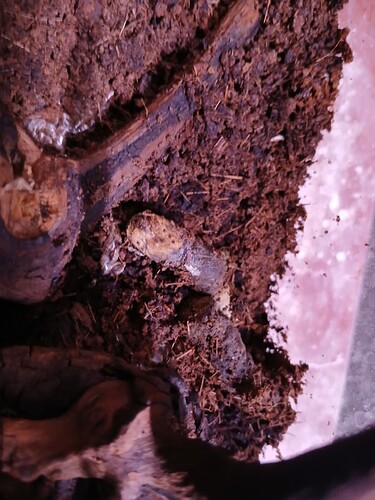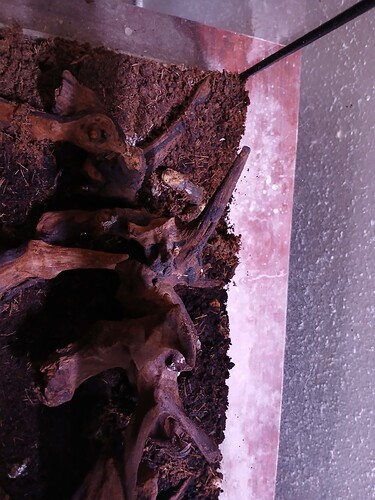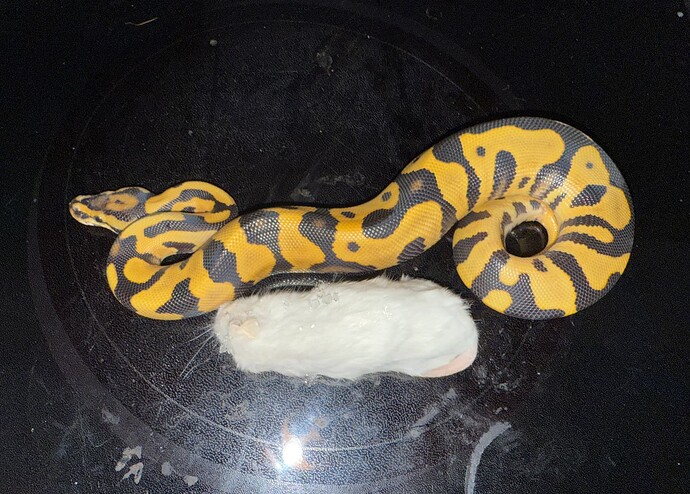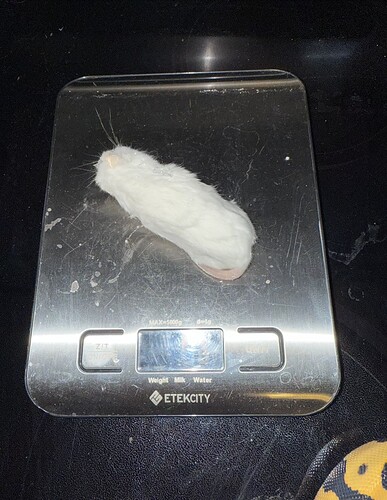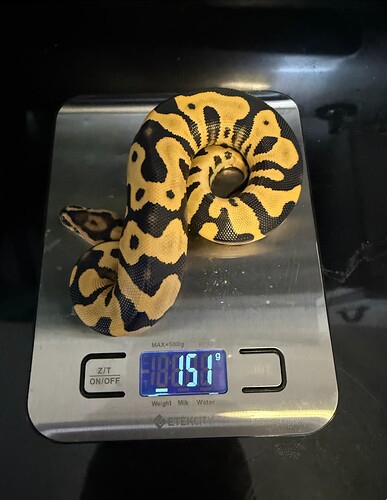You can clearly see how large the meal is compared to her.
We aren’t saying you should throw money at your problems. We are saying this animal needs help.
I’m sorry that you are let down by our strict guidance, but at the end of the day the animal’s health is much more important than the owner’s feelings.
I say what I say because this animals condition is very obviously not a healthy one, reguardless of who is at fault. Whether it be stunted growth or a life limiting congenital problem.
I don’t pull my advice out of thin air to berate you, I’m saying this as a person who has had 2 years of experience with reptiles in a Veterinary setting and 16 years of experience keeping reptiles in general.
There is something wrong with this animal, and I say this because I have just over a month old baby Ball Pythons that will be ready in a few more weeks to take meals the same size as what you are feeding your 3 year old Ball Python.
Heres one of the largest babies from my clutch for example, who is pushing past 70 grams and is taking 10-12g ASFs now.
The only way you will find out what is wrong is to get the BP to a Veterinarian even if you have to travel hours to do the visit. It sucks but there are breeders out there that have to do this.
If you are so sure this is a case of Dwarfism then the only person who will tell you this is a Veterinarian or some kind of specialist.
The reason some of us have a bad taste from all of this is that this was originally a post asking if this snake was a new morph, which no it is far from it, and presented us with very concerning images and description of this animal with no intitial inclination from you that this animal’s health situation was not good.
If we really didn’t care about this animal’s health nobody would have made a fuss over it.
As someone who has come to MM for medical advice for a herp before, this is it exactly.
Also most medical help threads never get tense at all, as most keepers/breeders are able to admit they don’t know everything and sometimes need to defer to others (especially professionals like vets) to do what is best for their animals.
If you care for this snake, PLEASE get her to a vet - after this much time without proper nutrition, her organs could be stunted, her heart could be overworked, her kidneys could be strained etc. She could also have a hidden internal issue that caused her hesitation on eating in the first place.
Vets are expensive and hard to find, believe me I get that, but part of owning an animal is accepting all responsibility for their care (and this also means NEVER breeding this animal PLEASE)
Said with no hate, only concern for the animal, just like everyone else
I think the issue with things getting jumbled is you haven’t really given a direct timeline. I also understand we’ve been asking a lot of questions of you which makes it harder to follow along. Would you be willing to perhaps provide a brief timeline from hatch to now of notable things that have happened/you have tried? That may give a better idea of what we’re looking at.
I will say, no vet is going to openly claim to know more than seasoned breeders, because that’s not how vets work nor advertise in most cases. Part of the problem with the lack of experience in exotics vets rests on the fact that many in the hobby adamantly refuse to take their animals in, meaning they don’t get to see them as regularly as other exotics. You can’t learn without exposure. That said, with some research, you can indeed find vets with many years of experience treating ball pythons. The clinic I mentioned was one I found mentioned by keepers elsewhere as where they take their own snakes. At least one of the vets there has done research on paramyxovirus in snakes, as well as exotics work at a zoo and wild animal park. Another has a pet BP themselves. Several had exotics focused education. Sometimes you have to shop around to find the right vet, get second opinions, even travel a bit and pay a bit more. It’s part of the responsibilities of long term keeping/breeding. If you are unwilling to do so, at some point you will be doing more harm to a snake than good. Not everything needs a vet, but some things just can’t be done by us as keepers.
I’m glad that you trust this community to provide help, but even we have our limits as to what we’re capable and comfortable providing as far as advice and care recommendations. We don’t have eyes or hands on your snake, we can only work with what information we get from you, and right now signs are pointing to this being a problem with nutrition and growth restriction.
It’s not out of the realm of possibility your little one’s issue has nothing to do with the feeder size, and that this particular snake hatched with a defect that keeps it from processing meals effectively. The only way to figure if things internally are fine is to see a vet who can do exams and imaging. Until then, I hesitate to suggest any more intense support options because I’m not sure if they’d overwhelm her system and cause her to crash. It’s about what she can handle, as you know with being critical of sizing up feeders too quickly. Too much too fast can be just as bad as too little for too long.
This is unacceptable dialogue on this forum.
My wife and I own a construction company, operate another that I sold to a larger company, and own and operate a large dog grooming salon. Revenue from snakes is completely irrelevant to me, I don’t breed anything common that sells for more than a few hundred dollars. Rare species are the only thing I breed that even breaks the barrier of a thousand. Reptile money isn’t even on my radar. I’m staff member on this forum because of the scope of my experience with reptiles. I don’t get paid to do this.
I have been breeding ball pythons and many other species for over a decade. I gave you advice based on experience of keeping hundreds of ball pythons and producing and establishing thousands of them. That meal is too small for that snake to grow on. Plain and simple. A single mouse is acceptable for a few months at best. The snake’s frame is more than twice the size of an animal I would feed a mouse to. If you go back through this forum and look at posts myself and other long term veterans have made regarding feeding, I’m a very conservative feeder.
What is most clear to me in this thread, and I say this meaning no ill will, is that you have no idea what you’re doing. Ball pythons out of the egg should be taking meals larger than rat pinkies - they should be started on hopper mice or large rat fuzzies, and they should move to larger meals within honestly the first month or two of life. “Stimulating” them with crickets isn’t a thing - a ball python will never see crickets as food and therefore do not gain a hunting instinct from watching crickets crawl. They need large warm-blooded prey that is active, like a hopper or small adult mouse. The fact that you started them like this just reinforces to me that you don’t understand how to properly start them, and I’m not saying that to be mean; I’m saying it to emphasize that you cannot just push aside the advice you’ve been given in this thread as ‘unhelpful’ because you clearly don’t know enough about this species to be able to judge what is good and bad info. People who are much more experienced than you are giving you advice. I would really, really suggest you listen.
At the end of the day, if this snake is regurgitating meals, it needs to see a vet. Plain and simple, no ifs, ands, or buts. It’s not because the meals are too big - it’s because there’s something wrong. At that size this snake should be easily eating 20-25g meals, and ant that age even if stunted this snake should be significantly bigger than it is. Larger meals is the only way this animal is going to grow. If it is not growing, if it is regurgitating, etc. the only solution is to take it to a vet and figure out what’s wrong. That is what you can do to properly care for this animal.
It is okay not to know everything. What’s not okay is refusing to learn or take the advice of people who do know more at the expense of your animal’s health.
I would go further than @armiyana below ![]() Thats not fat, looks like a stool with alot of excess fluid.
Thats not fat, looks like a stool with alot of excess fluid.
@inspirationexotics
Wow thanks for pointing this out, I didn’t even notice this reading through it the first time.
This is not acceptable care for BP hatchlings.
I’m premising this with complete brutal honesty because this is where I draw my line, idk where you were told that this is a thing for starting off BPs with feeders, but its absolutely not.
BPs hunt based on heat, scent, and movement. None of those stimulations are given off by crickets and will not trigger a feed response.
This is just my opinion on the matter because I love all animals, I do not find it acceptable at all to leave rat pinkies out with uninterested snakes just to die slowly and not even be eaten. Even from a feeder standpoint its just a waste… I breed my own feeder rats and I would never let that happen in my care.
I believe this thread should be shut down. The op is most certainly not going to heed all the credible advice given by some of the best of the best on this forum. A rabbit hole has been created and it’s just getting deeper and deeper. There is no winning this discussion/argument. Period.
First off let me reply by pointing out, im 28, just graduated college, i have 4 welding certs, can weld any metal, i am osha certified, as well as first responder certified for infant child and adult,
When this clutch was born yes it was my first clutch, yes i am an amateur breeder but in no way do i lack in comparison to any other owner, vet, or breeder, their might be tips i dont know but as far as knowledge this is what i have chosen to occupy my time,
This clutch was born 2022 july 6th after my god mothers bday,
The father , a male gargoyle pushing 2200 g,
The mother, a pastel lesser well over 2700 g,
All babies did better then this one that found homes, some unfortunately died in the egg,
The first day off life i allowed them to fully pip, after that they were introduced to a tank i specifically fixed up for hatchlings, in the second day of life i introduced, newborn rat pinkies that where on there second day of life for i meticulously breed rats to fit feeding and hatchling scheduals,
As i was saying on the second day of the hatchlings being out of the egg they literally let the rat pinkines wriggle and dry out until they died in the substrate, once witnessing this, i headed to the pet store, got the biggest crickets they had in stock, at witch point still on the second day, i introduced at least 10 crickets to the environment at witch point all six babies still showed no intrest, i left it be went to bed woke the next morning to not a cricket in site,
Witnessing this on the third day i went back to the pet store, bought round 2, waited till day 6, and on day 6 introduced round 2, at witch point the same thing, babies showed no interest, but i go to bed wake up all crickets gone,
At the start of week 2 this is when finally i could dangle new born pinkie rats infront of all the babbies and they ate them, even the one im having trouble with, the next 3 weeks still the first month all babies where fed on rat pinkies every week, goung into month 2, first week is when i uped the food of all babies to rat pinkies that where in there first and a half week of life so good sized pinkies, this is when all other babies besides this one ate there food exept here at wich point i still had newborn rat pinkies that she did eat, all other babies went up and up and found homes, she on the other hand at a year of life when all her siblings found homes she became my favorite and i vowed no matter ho meticulous id pay close attention, and do what ever, how ever when going into the second year and the only change i got her to was from pinkie newborns, to pinkie week and a halflings, i started to question my own sanity, even before she was on week and a halflings i tried to assit feed her with another pinkie newborn at witch she regurgitated it, so feeling content at week and a halflings thats when i came to this forum and for a whole year ive meticulously mentioned efforts ive made, completely explained things, and everytime with photographic evidence her meals have increased, her meals have been steady at every week the same size, (not the month mentioned by a previous owners statement)., and she still doesnt grow but her meals have to the point to where i said i no longer will feel comfortable with any other suggestions to increase the size of her foo, as far as vet suggestions i am listening and as soon as my financial status raises to afford a vet visit its not that i wont its simply i cant, i cant afford it, and all ive been met with in life besides racism, inadequate vetenarians, and opression is a hard life, yes i value my intelligence, yes i value my animals, maybe someone should ask me what vets ive visited, how many rare morphs out of my collection ive lost because of vets stupidity, and how many thousands of dollars ive lost at a young age while facing racist opposition,
(Krg black pastel lesser)
(2500 g female piebald that had the clutch of my male orange dream enchi ghost spider bp)
Sthousands of dollars spent, my pie bald died vomiting blood all over my 2020 altima, and besides burring my animals and spending money on vets as well as lab work, to not her anything, i ferl i have a right in my area to be well irratated.
Ball python hatchlings will still be living off the absorbed yolk until at least a week, which is usually about when they have their first shed. It’s honestly just a waste of your time and stress on them to try feeding at any time before they have that first shed cycle. Most of mine will start showing a food response around day 10
It’s extremely rare for one to show a feeding response out of the egg.
I wouldn’t try anything like a cricket because of the incidence of carrying pinworms being so high as well as the ball pythons not wanting anything to do with them. Even smaller snakes like colubrids won’t if they’re not an omnivore species. The rats you can at least have dewormed prior to breeding to make sure you have a clean colony to start with.
Stool is solid, and they went from, inubator in the egg, to piped, to in the egg and incubator until they had there first shed, i also cleaned there eggs out to avoid infection, and once i witnessed there first sheds, thats what i mean by first days out of the egg, they where then placed into an infimary tank for there infancy till new homes, she is my only case of specialty.
It sounds to me like:
a) you fed rat pinkies, which are too small to start ball pythons on and much too small to keep them on - and week and a half old pinkie rats are much too small for her to gain any actual nutrition from.
b) you tried with crickets, which are not, never have been and never will be acceptable food for ball pythons. They didn’t show interest because they don’t and will never eat crickets. The crickets escaped, the snakes did not eat them.
c) you started feeding too early (they live off of their yolk for the first weeks after they shed and will not take a meal until they have their first shed)
d) you kept them all in the same tank? You said “a tank i specifically fixed up for hatchlings.” Ball python babies should not be kept together past their first shed, they should have all be kept in separate enclosures.
e) it sounds like she regurgitated after you assist fed her, which likely means you assist fed wrong. The regurgitation problem is therefore not with meals being too big, it’s related to stress having to do with assist feeding.
This is what I meant when I said you have no idea what you’re doing. I’m really not saying this to be mean, I’m saying it to emphasize that you truly have no clue how to properly care for these animals and therefore you should absolutely be taking the advice folks in this forum are giving you.
No one here knows what race you are. No one is being racist. We’re all trying, I promise you, to help you take care of this snake properly. This snake will not grow unless you give her properly sized meals. At her size, that should be something 20 grams or more, absolute minimum. If you are not willing to do that, you should relinquish her to someone who is. The problem is 100% that you are not feeding her appropriately sized meals. You have never given her appropriately sized meals. Pinkie rats are too small from the jump, and even if you started on pinkies, she should have graduated to larger rat fuzzies within weeks of her first meals. The size rodents you are feeding her are not sufficient to allow her to grow.
I wonder if a visual size reference might help here. I have posted, below, one of my own three-month-old ball python hatchlings. At three months old, this hatchling is eating full grown adult mice or small rat pups. I have pictured a full grown mouse feeder here, with the snake for size reference, and on the scale for weight reference (the flash messed up the scale reading but it says 35g for the feeder mouse). Your snake should be getting meals barely smaller than this, within 10g of this size.
Ok so here is one of the most important pieces of information that you have shared in this thread. Having the finances available for at least standard exotic vet care is just as important as having access to a reputable exotic vet. Plain and simple, if you don’t have money for a vet, then you should not even consider keeping a reptile, much less breeding reptiles. I am sorry for the situation you have found yourself in but until you can dig yourself out of it you definitely should not breed any more animals, if nothing else as a favor to them……
I will say this implies to me that you feel we are attacking your character as a capable person - this is not the case. Your race, profession, etc are not being pulled into focus here, the questionable care you have repeatedly outlined is what is the focus.
Everyone here is focused on the animal, not you (I mean that kindly, you personally are not the focus here). Your questions about the animal being a new morph or a dwarf despite the answers to both being very much no suggests you want to breed this animal despite her stunted growth and ongoing issues.
We just want what is best for this animal, who has been malnourished for 2 years.
I want so many herps right now but can’t access a vet or reliable food sources, so even if my landlord allowed it, I wouldn’t buy a snake right now - its a sad thing, but sometimes the most responsible thing is rehoming. I’m doing that right now with my hermit crab, who is alone after his tankmates passed over the years. I’m going to miss him so much, but it is better for him to be with other crabs, and that is my responsibility as his owner.
Everybody take a deep breath and come back to thread to tomorrow. Not much is being gained and this topic could use a break.
Better not tell me the vets names, but I will ask you. how many vets and how many morphs have you lost and to what?
If this topic continues to be combative from both sides, I will close it today.
Everyone take a big step back. The entire conversation needs to be directed at animal care and husbandry.
Big hugs to you @ballornothing, you’re doing a great job moderating and we appreciate you! ![]()
Because you originally wanted to know if this snake was a dwarf and are hung up on that aspect, I figured I’d explain what we are seeing that indicates it isn’t, and what its current condition would mean even if it were.
Dwarf animals are not just smaller. They still grow proportionately. If you’d like you can take a look at the thread about Bantam corn snakes for an example of this. While those snakes do have a slower growth rate, they are still growing and gaining weight steadily. They have an overall healthy look and good body condition. No visible ribs, thick top lines, skin is tight to the body without any wrinkling. Their bodies are shorter than usual, and their patterns compressed compared to that of a normal corn snake. Note that the pairing that produced them produced multiple animals with the same mutation.
Looking at the photos of your animal, especially the initial ones, the body condition indicates a noted lack of nutrition and hydration. Visible ribs, wrinkled skin, and a prominent spine with a step from the bottom of the ribcage to the belly. Even your more recent photos, where she appears to at least have put on some body fat, show pretty severe skin wrinkling, which can be a sign of significant dehydration or other issues. Combine that with the bulbous lower third of her body and her overall condition, I’d be worried about possible kidney or digestive issues. You posted in February that she was 104g, and you estimate her current weight at 118g, meaning she’s only gained 14g in two months. Her head appears oversized to her body in your first photos, but less so in the most recent ones. She has the same proportions, for the most part, as a typical BP. This is the only animal in that clutch that has this appearance, and you noted it hatched out looking the same as the rest of its siblings, who all grew normally. That means even if this was, by some astronomical chance a new mutation, it was a one-off.
Now, the hypotheticals if she were in fact, a dwarf. With her growth rate and body size, she could never be bred, ever. If she proves female, there is no scenario in which there would be a male small enough to safely copulate with her. She’d be torn apart or crushed. If proven male, the same applies. It likely wouldn’t even be capable of inserting a hemipene at all, even if it were fertile.
The value in new morphs comes from their ability to be propagated and sold. This snake will very likely never be capable of reproduction, meaning even if it were a dwarf, it has zero value in the hobby. On top of that, as a one-off, there would be no guarantee it could be passed genetically, anyways. I hope this helps clarify things a bit more.

